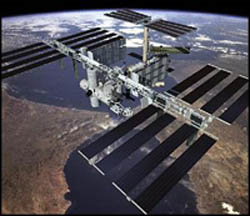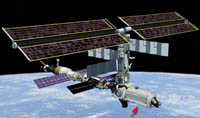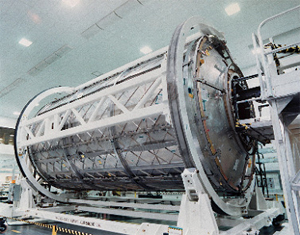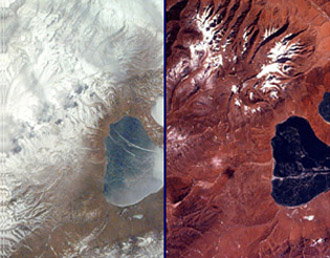The International Space Station (ISS)

Digital drawing of ISS when completed
Sally Ride EarthKAM's Home on ISS

The window in which the Sally Ride EarthKAM ESC will be mounted aboard the ISS
The Sally Ride EarthKAM camera was the first operational payload in the US Laboratory, named Destiny (shown below). Both Destiny and Sally Ride EarthKAM flew in February of 2001, on STS-98 (flight 5A). The aluminum lab is 28 feet long by 14 feet wide and is composed of three cylindrical sections and two endcones, used to mate the lab to the other station components. The crisscross aluminum struts visible in the picture add strength to the hull without adding excessive weight. A debris shield blanket now covers the struts, and a thin aluminum debris shield placed over the blanket adds further protection from the harsh environment of space.

The US Laboratory, Destiny, shown here in the fall of 1997 under construction at Marshall Space Flight Center in Huntsville, Alabama
With the placement of Sally Ride EarthKAM on the International Space Station, students will not have to wait for a Space Shuttle flight. Missions now occur about once every three months, where each participating school is assigned a time period in which they can submit pictures for the camera to take. For more information about involvement in Sally Ride EarthKAM, please visit our Educators section.

Comparison of two images of the Tibetan Pleateau - The image on the left was taken in March of 1996; the image on the right was taken ten months later, in January of 1997
 |
The NASA International Space Station Official Site Explore the space station, the crews, and the missions in-depth |
|---|
Research on the ISS
The International Space Station provides scientists as well as students with a unique opportunity to do research in the microgravity conditions of space for extended periods of time much longer than a Shuttle mission. In space, objects seem to weigh a lot less than they do on Earth because the pull of gravity is not as strong. Many everyday processes depend on gravity. For example, sedimentation is the separation of particles based on their weight, with the heavier ones sinking and the lighter floating. Without gravity, not only would things not fall down, but items that normally float would not necesarily retain this buoyancy (e.g. ice cubes would not automatically float to the top of a glass of water). The research conducted on the station includes many different areas of focus, all of which aim to improve everyday life. Some of these areas are:- Earth Science
From more than 200 miles above the Earth, our planet can be viewed and studied at a unique vantage point. Trends in atmoshperic quality, weather, climate change, vegetation and land use, mineral and food resources and health of fresh and salt water can all be seen and analyzed from the ISS. Sally Ride EarthKAM was the first of such projects on the ISS. The Sally Ride EarthKAM digital camera is mounted in the Destiny Laboratory window, and students from participating middle schools select pictures to be taken. After these locations are photographed, students are able to study these photos first hand. - Space Science
Above the Earth's atmosphere, outer space can be observed with greater clarity. The ISS will give much more opportunity for astronauts to explore near and distant galaxies as well as our own solar system. The Sun and its effects on the Earth are other areas to be examined. - Life Science
On the ISS, researchers have the opportunity to study the effects of living in space on both human and animal subjects. In the absence of gravity, several physiological changes occur. Fluids that are normally held down by gravity rise, causing the upper portion of the body to swell. Without the pressure from the weight of the body, bone calcium is lost and unused muscles deteriorate. For the health of the astronauts, it is important to study these effects and find countermeasures to slow them down. Currently, exercise is used to keep astronauts physically strong. - Microbiology
In addition to studying the astronauts, researchers will investigate the role of gravity on cellular and molecular structures. Without the restrictions of gravity, many of these structures will grow differently. By studying the evolution, development and function of various biological processes, researchers hope to gain a better understanding of how they work. - Biotechnology
Biotechnology is the application of engineering and technology in life science. Two areas of biotechnology will be primarily explored on the ISS. The first of these, protein crystal growth, will be studied by cultivating certain proteins. In the absence of gravity, these proteins grow larger and with greater perfection, making them easier to study. The second area of research will involve cell and tissue culturing. These studies will use bioreactors to grow human tissue outside the body. By doing this, scientists can study the effects of various medicines on these tissues without harming humans. Someday, these tissues may directly transplant damaged tissues. - Materials Science
Materials science studies how materials are formed and the properties they possess (e.g. thermal, magnetic, chemical, et cetera). In the absence of gravity it is possible to form materials in different ways that may yield better combinations. - Combustion Science
Combustion science is the study of how fire burns. Normally, gravity draws cool, heavy air down and causes the hot, light-weight products of combustion to rise (that is, a flame is always oriented vertically). Without gravity, fire behaves quite differently than on Earth. Studying combustion may help make its use here on Earth as an energy source more efficient, and also make advances in space flight fire safety.







